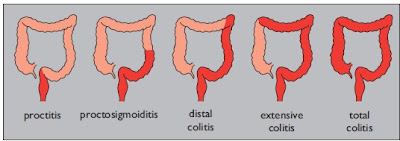what are the types of ulcerative colitis
The symptoms of ulcerative colitis can vary depending on the extent and severity of the inflammation.
Because of this, it helps to know which part of your colon is affected. The diagram shows the types of ulcerative colitis,
from the most limited, proctitis, involving just the rectum, to the most extensive, pancolitis, involving
the entire colon. In general, if you have extensive disease your symptoms will be more severe, but there are exceptions. For example,
you could have severe proctitis or mild pancolitis. In most people UC does not become more
extensive over time, but in about two people out of ten it spreads up the colon after 10 years.
the entire colon. In general, if you have extensive disease your symptoms will be more severe, but there are exceptions. For example,
you could have severe proctitis or mild pancolitis. In most people UC does not become more
extensive over time, but in about two people out of ten it spreads up the colon after 10 years.
• ProctitisBecause inflammation is limited to the rectum in proctitis, the rest of the colon is unaffected and
can still function normally, so symptoms tend to be milder. For many people with proctitis the
only symptom is bright red bleeding that may be mixed with mucus. You may get diarrhoea, but
you may have normal stools and in fact you may get constipation. If the inflammation is severe,
you may feel pain in the rectum and an urgent need to rush to the loo, but pass only wind. Also,
the skin around the anus may become irritated.
can still function normally, so symptoms tend to be milder. For many people with proctitis the
only symptom is bright red bleeding that may be mixed with mucus. You may get diarrhoea, but
you may have normal stools and in fact you may get constipation. If the inflammation is severe,
you may feel pain in the rectum and an urgent need to rush to the loo, but pass only wind. Also,
the skin around the anus may become irritated.
• ProctosigmoiditisThis type of ulcerative colitis affects the rectum and sigmoid colon. Like proctitis, symptoms include bleeding
and a sense of urgency.
and a sense of urgency.
• Distal or Left-sided ColitisIn this type of ulcerative colitis the inflammation starts at the rectum and continues up the left side of the
colon – the sigmoid colon and the descending colon. Symptoms include diarrhoea with blood
and mucus, loss of appetite, weight loss and severe pain on the left side of the abdomen.
Diarrhoea tends to be less frequent with fewer than six loose stools a day.
• Extensive and Pancolitis or Total ColitisWhen ulcerative colitis affects most of the colon or the entire colon, this usually causes very frequent watery
diarrhoea with blood and mucus. If the inflammation is severe you may have diarrhoea as often
as 20 times a day, and you may become dehydrated (see our information sheet: Dehydration).
You may also have severe abdominal pain, cramps, fever, and extensive weight loss. Milder flare-ups
may cause diarrhoea or looser stools without blood. Very rarely, when inflammation is severe,
gases can get trapped in the colon causing it to swell. This is known as toxic megacolon and
causes a high fever and pain and tenderness in the abdomen. It is essential to get treatment
quickly as there can be complications.
causes a high fever and pain and tenderness in the abdomen. It is essential to get treatment
quickly as there can be complications.











0 comments:
Post a Comment